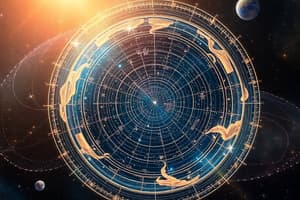Podcast
Questions and Answers
What is the primary focus of celestial mechanics?
What is the primary focus of celestial mechanics?
- The study of terrestrial ecosystems
- The relationships between electricity and magnetism
- The motions of objects in outer space (correct)
- The interactions of forces on Earth
Why did the geocentric model initially gain acceptance among philosophers?
Why did the geocentric model initially gain acceptance among philosophers?
- It accurately predicted planetary movements
- It included the concept of gravity
- Earth appears stationary and solid to observers (correct)
- It was based on detailed astronomical calculations
What motion does the Sun exhibit according to the geocentric model?
What motion does the Sun exhibit according to the geocentric model?
- It revolves around Earth once per day (correct)
- It moves in a circular path around the stars
- It remains stationary relative to the Earth
- It exhibits a random motion pattern
What is one characteristic of the stars in the geocentric model?
What is one characteristic of the stars in the geocentric model?
According to Aristotelian physics, how are celestial objects arranged?
According to Aristotelian physics, how are celestial objects arranged?
What is the perceived daily motion of stars from an Earthbound observer's perspective?
What is the perceived daily motion of stars from an Earthbound observer's perspective?
How frequently does the Moon revolve around Earth according to celestial mechanics?
How frequently does the Moon revolve around Earth according to celestial mechanics?
Which aspect of celestial movements is NOT included in the geocentric model?
Which aspect of celestial movements is NOT included in the geocentric model?
What does Kepler's third law of planetary motion state?
What does Kepler's third law of planetary motion state?
Which observation method did Galileo utilize to challenge the geocentric model?
Which observation method did Galileo utilize to challenge the geocentric model?
What was Tycho Brahe's contribution to astronomy?
What was Tycho Brahe's contribution to astronomy?
What effect does distance from the Sun have on a planet's orbital speed, according to Kepler's third law?
What effect does distance from the Sun have on a planet's orbital speed, according to Kepler's third law?
How did early astronomers originally perceive the motion of celestial objects?
How did early astronomers originally perceive the motion of celestial objects?
What did the observation of planetary retrograde motion lead to in terms of models of the solar system?
What did the observation of planetary retrograde motion lead to in terms of models of the solar system?
Which model of planetary motion did Kepler advocate?
Which model of planetary motion did Kepler advocate?
What was a significant impact of Tycho Brahe's astronomical observations on future science?
What was a significant impact of Tycho Brahe's astronomical observations on future science?
What is the shape of the orbit of all planets according to Kepler's first law of planetary motion?
What is the shape of the orbit of all planets according to Kepler's first law of planetary motion?
Which of the following statements accurately reflects Kepler's second law of planetary motion?
Which of the following statements accurately reflects Kepler's second law of planetary motion?
What observation prompted Kepler to search for a non-circular orbit for Mars?
What observation prompted Kepler to search for a non-circular orbit for Mars?
What did Kepler attribute the faster motion of planets to as they approach the Sun?
What did Kepler attribute the faster motion of planets to as they approach the Sun?
Which term describes one half of the major axis of an ellipse?
Which term describes one half of the major axis of an ellipse?
What is the relationship between the distances of points on an ellipse and its focal points?
What is the relationship between the distances of points on an ellipse and its focal points?
What model did Tycho propose before Kepler formulated his own views?
What model did Tycho propose before Kepler formulated his own views?
Which of the following was a motivation behind Kepler's view of the Sun?
Which of the following was a motivation behind Kepler's view of the Sun?
What does the equant point represent in the Ptolemaic system?
What does the equant point represent in the Ptolemaic system?
How did Copernicus' heliocentric model differ from the Ptolemaic geocentric model?
How did Copernicus' heliocentric model differ from the Ptolemaic geocentric model?
Which of the following best describes the motion of planets in the Ptolemaic system?
Which of the following best describes the motion of planets in the Ptolemaic system?
What phenomenon does planetary retrograde motion refer to?
What phenomenon does planetary retrograde motion refer to?
Why was the equant introduced in the Ptolemaic system?
Why was the equant introduced in the Ptolemaic system?
Which celestial motion is explained by Earth's rotation around its axis?
Which celestial motion is explained by Earth's rotation around its axis?
What was a significant outcome of Copernicus' model regarding celestial motions?
What was a significant outcome of Copernicus' model regarding celestial motions?
Which of the following concepts was adapted to explain the variability in celestial motion in the Ptolemaic system?
Which of the following concepts was adapted to explain the variability in celestial motion in the Ptolemaic system?
What is the correct expression for momentum as defined by Newton?
What is the correct expression for momentum as defined by Newton?
According to Newton's second law, how is force related to mass and acceleration?
According to Newton's second law, how is force related to mass and acceleration?
What does Newton's third law state about the forces exerted by two bodies on each other?
What does Newton's third law state about the forces exerted by two bodies on each other?
What is the principle of conservation of momentum regarding two interacting bodies?
What is the principle of conservation of momentum regarding two interacting bodies?
How is the acceleration of a planet related to its distance from the Sun according to Newton's laws?
How is the acceleration of a planet related to its distance from the Sun according to Newton's laws?
What is the physical cause of the acceleration of planets as implied by Newton's laws?
What is the physical cause of the acceleration of planets as implied by Newton's laws?
What does Newton's second law imply about the relationship between force, mass, and momentum?
What does Newton's second law imply about the relationship between force, mass, and momentum?
What is the relationship between mass, force, and the distance from the Sun for a planet as described by Newton's laws?
What is the relationship between mass, force, and the distance from the Sun for a planet as described by Newton's laws?
Flashcards are hidden until you start studying
Study Notes
Celestial Mechanics: Overview
- Mechanics examines the relationships among force, matter, and motion of physical objects.
- Celestial mechanics specifically focuses on the movements of objects in outer space.
Historical Models
- The geocentric model posited Earth at the universe's center, supported by the following observations:
- Earth appears stationary to observers.
- Celestial bodies (Sun, Moon, planets) seem to revolve around Earth daily.
- Early philosophies, especially Aristotelian physics, described celestial objects as embedded in concentric spheres rotating at fixed rates.
Key Concepts in Astronomical Observations
- The geocentric model characterized celestial objects (stars, planets) as orbiting Earth.
- The stars display a daily westward motion, while the Sun, Moon, and planets have distinct motion patterns.
- Planetary retrograde motion puzzled astronomers until resolved by later models.
Copernican Revolution
- Nicolaus Copernicus introduced the heliocentric model, placing the Sun at the universe's center, with the Earth and planets orbiting around it.
- Copernicus explained that daily celestial movements are due to Earth's rotation on its axis.
Kepler’s Contributions
- Kepler formulated three laws of planetary motion based on Tycho Brahe’s precise astronomical observations:
- First Law: Planets orbit in ellipses with the Sun at one focus.
- Second Law: Planets sweep out equal areas in equal times; their speed varies with distance from the Sun.
- Third Law: The square of a planet's orbital period is proportional to the cube of the semi-major axis of its orbit, indicating that farther planets move more slowly.
Newton's Laws of Motion
- Newton’s First Law: An object will not change its state of motion unless acted upon by a force.
- Newton’s Second Law: The change in motion is proportional to the force applied, expressed as ( F = ma ) (force equals mass times acceleration).
- Newton's Third Law: Forces between two interacting bodies are equal in magnitude and opposite in direction.
Relationships Between Forces and Motion
- Momentum is the product of mass and velocity: ( p = mv ).
- The conservation of momentum states that the total momentum in an isolated system remains constant.
- Newton explained Kepler's laws through gravitational principles, quantifying the acceleration of planets towards the Sun, proportional to the inverse square of their distance.
Law of Universal Gravitation
- Newton’s law asserts that every mass attracts every other mass, with the force of attraction inversely proportional to the square of their separation distance.
- This law highlights the mutual gravitational influence between celestial objects, including the Sun and planets.
Summary of Key Concepts
- Historical observations led to the transition from the geocentric to the heliocentric model.
- Tycho’s data and Kepler’s laws established foundational principles of planetary motion, transforming celestial mechanics.
- Newton unified motion and gravitation, linking observed motions of celestial bodies to laws governing force and mass.
Studying That Suits You
Use AI to generate personalized quizzes and flashcards to suit your learning preferences.




